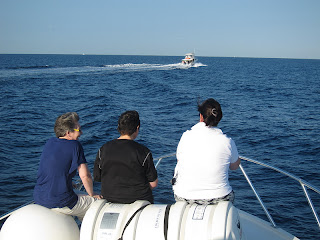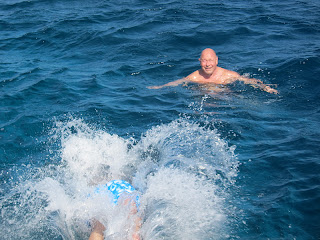Hard to believe that the fireworks in Dubai for New Year are now a month in the past. Our lives continue on as anywhere with our routine work days, as retirement or semi retirement is still a ways off. Although we have not been able to have "gone cruising" we attempt to make the most of our "adventure careers" (??) in our spare time to make the most of a location which is out of bounds for the standard tourist. As alluded to in previous Blogs we intermittently spend our weekends going diving in the Red Sea, a region Jacques Cousteau made famous in his original book, now unfortunately out of print, "The Silent World".
The weather in January in Jeddah is generally quite pleasant with some days getting up to 30 deg C but mostly in the low to mid 20's C. However the waters of the Red Sea do cool down somewhat compared to during the steamy hot summers here although never really cold. Longer sleeves however make things more comfortable when voyaging on the dive boats where the breeze off the water when going offshore may have a slight chill. However mid January on a dive boat in the Red Sea is one of the joys of "winter" in this region.
Getting to the dive boat early has the advantage of setting up one's equipment and putting the tank in a location of choice before the "crowd" arrives (approximately twenty people on a typical dive boat trip). Yes this is mid January.
Then for that first cup of coffee early in the day. The coffee tastes so much better while on the water, with the soft sunshine of the morning and anticipation of heading offshore.
Finally underway and heading for the horizon, with another dive boat heading out ahead of us to a different location - there are lots of reefs to explore. The chain of reefs is about ten to fifteen miles offshore. A beautiful January day.
The stern of our boat with the early morning sun sparkling on the wake. That is mainland Saudi Arabia on the horizon far behind us. The boat trips themselves are worth the trip being able to get offshore out of sight of land.
Both the journey as well as the destination bring that sense of peace.
Almost ready to go as we have anchored just off our first reef destination. This full wet suit is for the tropics being thin but nice to stay warm if down at fifty feet or more for over half an hour.
Final check by the dive boat crew that the air valve on the tank is indeed fully open before making the jump off the stern into the water. The previous diver has made the plunge as can be seen by the splash. The reef can be seen in the background on the left.
The skipper almost ready to descend to the depths. Usually I have 12 to 14 pounds of weight on (in my integrated weight belt) but have to let the air out of my BCD (floatation gear strapped to me that also holds the scuba tank) to descend, making sure I equalize the pressure in my ears for every few feet of descent..
Looking tired on getting back on board after the first dive of the day.
Usually when swimming the face of a reef you head out until close to fifty percent of your air is gone then turn around and head back - this time the current we had to swim against on heading back was far stronger than anticipated using up more air than one wished with the much greater swimming effort needed. Hence I slowly headed up to a lower depth (a safety stop depth of about fifteen feet, needed to assure adequate decompression) in case I should run out of air and had to surface. If that had happened I would have had to make some of the trip back to the boat on the surface using my snorkell.
Even Joy, who had been just snorkelling along the reef, had noted the current on coming back - but now all smiles, being back on board. A day on or in the water however beats a standard day at work anytime.
Between dives it is great to relax, socialize, rehydrate ourselves, and eat. One or two hours between dives at the surface is needed for decompression reasons.
At our break we also found that throwing small crumbs of food in the water brought some of the smaller reef fish to the surface to feed.
During our break from diving it was also an opportunity to jump off the boat just to go swimming - the water was beautiful although a little cooler than during the height of summer when it can be almost too warm.
When moving the boat to our next destination we passed this surf over one of the shallower reefs. Many of the reefs however are harder to see. Although the map GPS we had on board was helpful in this regard, as with all GPS systems we still needed to rely on basic piloting with a good lookout, particularly in these waters that have claimed their share of shipwrecks..
Our next dive site was to be over the "Chicken Wreck". Many of the shipwrecks here are named after the cargo they were carrying, this particular one frozen chicken! This was an event for myself and Mitch (seen in this image) as this was the site of one of the first dives I did in 1998 during my initial dive licence training (PADI Open Water), and was to celebrate Mitch's 500th dive!
A moment in each of our own personal histories, just before descent.
Diving onto wrecks I have always found fascinating, not only because of the vistas that can be seen and the sea life associated with these "artificial reefs", but also the history and stories behind these unfortunate events.
But today, as if for part of a celebration, we were to witness an event that only comes along rarely - it started by us seeing four large forms of sea life swimming away from us into the blue ..... shy creatures sometimes, but not always, with many stories in maritime folklore. At this juncture I will digress.
During the long course of history, and with Cousteau's descriptions of diving in the Red Sea, sharks appear in one's mind. But sharks are actually only rarely seen while diving here, although they are clearly present - and to be respected when encounted. But another form of large sea life is seen more commonly, but usually only in small numbers.
That animal is the dolphin, a mammal being a member of the whale family and a close cousin to the killer whale. They are intelligent animals that have been trained in captivity (such as seen from my Blog on Dubai a month ago), but in the wild they can be friendly or shy.
Dolphins in captivity from our trip to Atlantis in Dubai. Yes they can be trained to do tricks and have friendly interactions with humans, although clearly there is not total agreement that we should be doing this - as discussions may take place regarding animals in zoos.
Here next to our anchored dive boat is a large pod of dolphins - counted to be 15 to 16 of them, somewhat shy coming close but not too close. If this picture is enlarged one can see some of them, particularly on the left side of the image, and the snorkeller on the bottom edge. It was difficult getting good pictures of them from the boat, but an amazing experience to watch this large family. Some of them were the "tails" swimming off into the blue that Mitch and I saw when we were diving.
A great day on and in the water!
Heading back to the marina & dive centre in Jeddah. Note in the last image as we entered the inlet at the north end of the city the numerous sea doos that came along to play in our wake. As noted on earlier Blogs a "no wake" rule is not observed.
All in all a great way to spend a weekend in January, and to be back at home with a nice shower an hour later.

















.jpg)






No comments:
Post a Comment